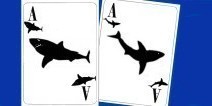|

Join our Newsletter
& get our free guide Starting Hands Revealed
We hate spam too!
We value your privacy and never share your email. All our emails have an opt-out link. Click it, and you will never hear from us again. pokerstars marketing code
in various languages
pokerstars review
in various languages
|
How To Deduce An Opponent's Hand RangeThe way to gain an edge
But what's the process you must use to deduce an opponent's hand range? Is there a basic formula you can follow to accurately figure out a range? Yes! It's basically this: start wide and end narrow. The more actions you see your opponent take in a hand, the narrower you should be able to define his range. Let's look at an example of deducing an opponent's hand range. Example: TAG Under the GunYou're playing short-handed $1/2 No-Limit Holdem, and you're on the button with a full stack. The blinds post, and a villain UTG raises to $8. MP and the CO fold, and the action's on you. Before you even look at your cards, let's ask ourselves: what's UTG's range here? To figure this out, we've got to consider everything we know about the player UTG. Let's assume the following:
Combine all this knowledge with the fact that UTG is raising 4xBB in the worst position at the table, and we can make a couple of conclusions regarding his range:
So our opponent's range consists of lots of broadway-type hands and some bigger pairs. It's a tight, solid value range, and what we'd expect from a decent player given the situation. Example Continued: You Hold QJoNow let's say you hold QJo against the opponent above. Knowing that his range is pretty solid, how should you play your hand? First, notice that your hand is also in your opponent's range. Meaning, he could be holding QJo as well. However, consider that since you've got a Q and a J, it's less likely that your opponent does as well. Thus his hand is more weighted towards A and K type hands, and less so towards Q and J type hands. Also notice that basically the only alternative to A and K type hands in his range are pocket pairs. Given all this, it's probable that you're dominated preflop. Running the hand hot and cold through PokerStove shows that you've got about 34.1% equity in the pot against villain's range, which isn't great. If you were getting less reverse implied odds -- i.e. you had less a chance of being totally dominated when you hit the board -- you might be able to raise and hope to hit a hidden straight or flush with suited connectors. But as it stands, your only possible results against villain's range are hitting top pair or a straight, both of which your villain would probably hit a piece of as well. So it's safest to fold in this scenario. There's no point in battling it out with a good TAG over such a marginal hand. It's All About InformationWe've just walked through the process of deducing an opponent's range preflop. As you can see, it's entirely a matter of logical deduction. We start by gathering all the relevant information we've observed, and proceed to filter the information through what we know about player tendencies and patterns. It's not a hard process -- it just takes a little time to get the hang of. You'll have noticed that since we begin with information as our springboard, the quality and amount of information we have will affect our reads significantly. For example, imagine if in the hand above we didn't know the opponent's VPIP or PFR statistics. We then wouldn't have been able to come up with a range as precise as 12% of hands from early position; we might have had to settle on a range of any two cards until we saw further action on the flop! So it's critical to gather as much information as you can as often as you can. Use tracking software, take good notes on opponents, and study interesting hands after each session you play. Knowledge is power in poker, and any information you can get translates into an edge for you at the tables!
Knowing this sort of information can make it easier to understand how to beat your opponents.
This is where some of the best players play online poker, like Vanessa Rousso, Jonathan Duhamel, and many others. And the best players know how to deduce an opponent's hand range. If you sign up at pokerstars, you can watch Vanessa Rousso playing there. Her username is 'LadyMaverick'. And you can even play with her, so check it out.

|











